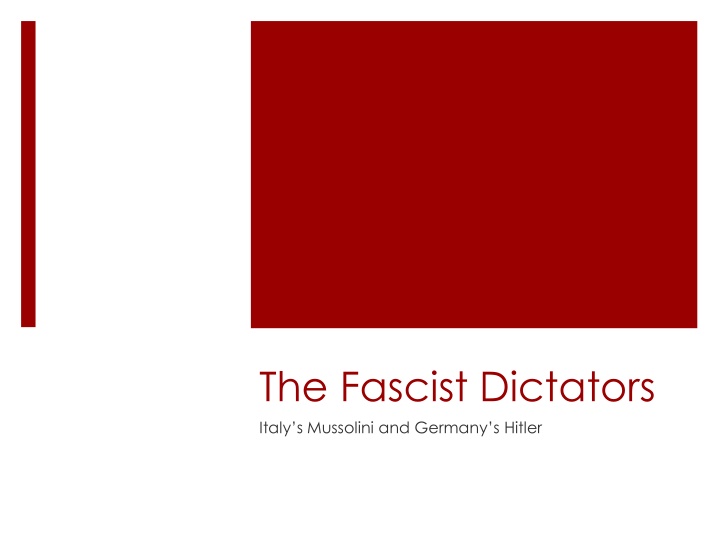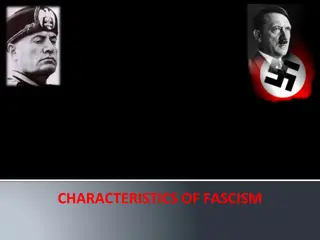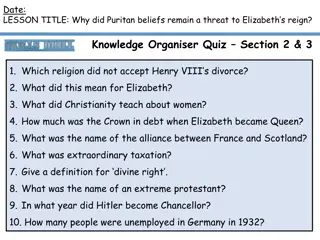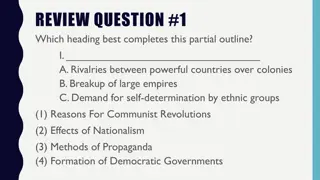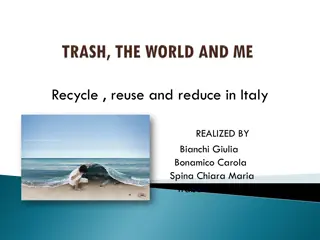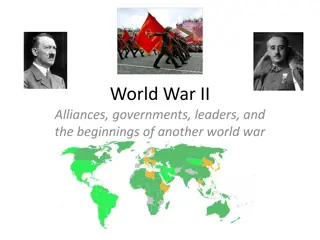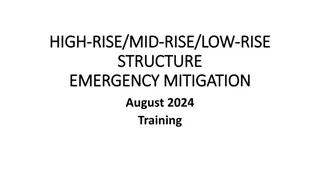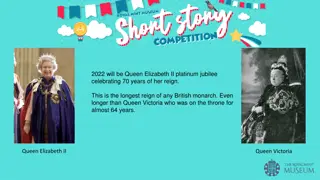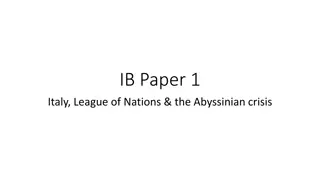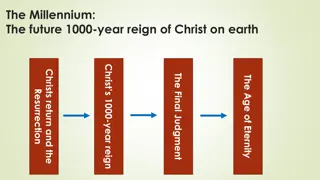The Rise of Fascism in Italy: The Reign of Mussolini
Italy's post-World War 1 chaos paved the way for Mussolini's rise to power as a dictator. Using violence and intimidation, the Fascists dismantled democracy, centralized power, and promoted extreme nationalism and militarism. Despite promises of order and greatness, Mussolini's regime suppressed dissent and led Italy down a path of authoritarian rule.
Download Presentation

Please find below an Image/Link to download the presentation.
The content on the website is provided AS IS for your information and personal use only. It may not be sold, licensed, or shared on other websites without obtaining consent from the author.If you encounter any issues during the download, it is possible that the publisher has removed the file from their server.
You are allowed to download the files provided on this website for personal or commercial use, subject to the condition that they are used lawfully. All files are the property of their respective owners.
The content on the website is provided AS IS for your information and personal use only. It may not be sold, licensed, or shared on other websites without obtaining consent from the author.
E N D
Presentation Transcript
The Fascist Dictators Italy s Mussolini and Germany s Hitler
The Rise of Fascism in Italy Italy fought on the side of the Allies in World War 1, with the promise of receiving Austro- Hungarian land. They were disappointed that they did not receive all of the land promised them. After the war, the Italian government was in disarray, with feuding factions and protesting peasants and workers. The Italian Fascist Party promised order amid the chaos.
Benito Mussolini The Italian Fascists created combat squads that attacked political enemies, such as the socialists. The Fascist paramilitary groups wore black shirts and used violence to intimidate their opponents. Their leaders was a fiery speaker, Benito Mussolini. He promised to restore order and a strong Italian government based on extreme nationalism.
Fascists Take Over Italy In 1922 thousands of Fascists marched on Italy s capital, Rome. The King Victor Emmanuel feared civil war. He gave in to the Fascists, asking Mussolini to become prime minister.
Dismantling Democracy Mussolini gave himself the name, Il Duce , The Leader He began to dismantle democracy by: Attacking rival parties Rigging elections Throwing opponents in prison On paper, Italy was still a parliamentary monarchy. In reality, Mussolini ruled as a dictator.
Fascism in Italy Mussolini brought businesses under government regulation. However, he did not do away with private industry, as the Stalin did. Individual liberties were abolished, and the state or government was the most important institution. Only one political party allowed, opponents of the government were imprisoned or killed.
Nationalism and Militarism Fascism glorified extreme nationalism and the use of violence. Believe, Obey, Fight was the slogan of the fascist government. Mussolini pursued a policy of rapid foreign expansion, especially in North Africa.
The Appeal of Fascism Mussolini promised Italians he would rebuild the Roman empire and return Italy to greatness. The Fascists restored order from the chaotic days after WW 1. Made the trains run on time. Mussolini projected strength, like a father figure who was feared but respected. Some people liked the sense of belonging created by the Fascist state. Nationalist pride.
Germanys Weimar Republic Why did democracy fail in Germany?
The Impact of the The Treaty of Versailles on Germany Germany was forced to take blame for World War 1 in the Treaty of Versailles. The Treaty demanded that Germany pay war reparations (payments) to the Allied nations. They also had to give up colonies and some land. Germany also had to dramatically reduce the size of its military.
The Weimar Republic of Germany After Germany s defeat in World War 1, a new democratic government was established in the city of Weimar. The Weimar government had a constitution, based a parliamentary system. The law making group was called the Reichstag. The leader of the Republic was the Chancellor, similar to a prime minister.
Political Groups in Germany The new Weimar government included voting rights for all citizens, including women. There were many competing political parties in Germany. The ruling coalition included the Social Democratic Party, Democratic Party and the Centre Party. On the left were the communist groups, and on the right conservative parties, including the Nazi Party.
German Inflation Inflation is the increase in prices. When prices go up people s money is worth less. In 1923 Germany faced hyper inflation, with rapid increases in prices. The Mark, Germany s currency, became almost worthless. It was so bad it took a wheelbarrow full of Marks to buy a loaf of bread.
Germanys Depression Germany recovered from the inflation with the help of the old Allies, who lowered the reparation payments owed by Germany. However, in the late 1920 s, Germany sank into a deep depression, along with many other western countries. A depression is when businesses close, unemployment rises and the output of a nation declines.
Hitler Appointed Chancellor The Nazi Party and the German Communist Party grew in influence as the economic conditions in Germany worsened. The Nazis promised to end paying reparations to the Allies and to create jobs. Fearing communist influence, the conservative German President, Paul von Hindenburg, appointed Hitler Chancellor of the in 1933.
Hitler Eliminates Opponents Soon after Hitler was appointed Chancellor a fire broke out in the German parliament, the Reichstag Hitler immediately accused communists of setting the fire and put many Nazi political opponents into prison. He passed a law which suspended freedom of speech, assembly, and political parties. Hitler killed key army leaders who opposed him, in the night of the long knives.
Hitlers Third Reich Hitler banned all political parties other than the Nazis, making Germany a one party, totalitarian, state. People pledged allegiance to the Hitler, the Fuhrer (leader) His secret police, the Gestapo, arrested or killed all opponents. Hitler promised to build a Third Reich, or empire, based on the idea that Germans were a master race that would rule Europe for a thousand years. The German government provided jobs through public works projects.
Nazi Propaganda The Nazis used speeches, rallies, flags, posters, art and film as propaganda. Nazi Propaganda promised German workers jobs and food, and to make Germany strong again. The Nazis appealed to extreme German nationalism and Aryan superiority , the idea that blonde, blue eyed, Germans were a superior race.
The Hitler Youth The Nazis organized children and teenagers into the Hitler Youth organizations. Children swore allegiance to Hitler and Germany. In schools German students were taught race science, which claimed that blonde haired, blue eyed Germans were scientifically superior to all other races of people
Anti Semitism Anti Semitism is prejudice and discrimination against Jewish people. This prejudice existed in Europe before the Nazis took power. Hitler and the Nazi Party blamed many of Germany s problems on Jewish people, making them scapegoats. The Nazis accused Jews of controlling German banks and also of being communists. Hitler viewed Jewish people as an inferior race, that would pollute the German master race, if they intermarried Aryans.
European Jews Judaism is a world religion based on the belief of a single all powerful God, found in the Old Testament. Judaism shares the same biblical roots as Christianity and Islam. In the 1930 s about 9.5 million Jews lived in Europe, less than 2% of its total population There were about 505,000 German Jews, or less than 1% of the German population.
Jewish Persecution in Germany In 1935 the Nazi regime stripped German Jews of their citizenship rights with the Nuremberg Laws. Jews were excluded from schools and professions. Intermarriage between Jews and other Germans was prohibited. Jews had to wear star of David for identification. In 1938 the Nazi Party terrorized Jews during the Night of Broken Glass, when they attacked Jewish businesses and synagogues.
